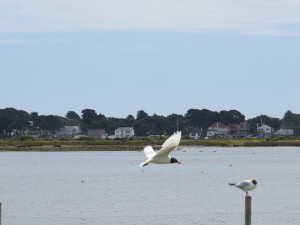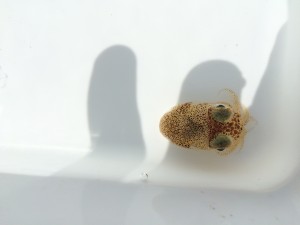Last year I spent a month with the local RSPB, Wez and Dawn based in Langstone Harbour. I returned this year and was able to link it up with my uni’s “Excel Placement” scheme so was paid which was nice. It’s been an interesting month; very different to last year, mostly down to the weather.
Before I arrived there were not one, but two storm surges and also torrential rain and winds. All had their various negative impacts on our seabirds. The gulls (black-headed & Mediterranean) and also sandwich terns nest earlier than the common and little terns so were impacted by both storm surges. The little terns survived the last storm surge, but sadly the wind and rain was just too much for them. Days after the storm surge, the majority of little terns abandoned their nests, feeling hungry and fearing for their own lives no doubt.
It’s not all bad news. There are some little tern chicks, and many of the black-headed gulls laid more eggs. The sandwich terns have done well too, as have the Mediterranean gulls. The common terns, however, seem to be suffering. This isn’t due to the weather. It seems to mostly be down to the Mediterranean gulls. With luck, as the gulls start to disperse, the terns will get some peace at last.
As part of my placement, I was helping Wez carry out chick provisioning surveys for Natural England. Each week 6 are carried out; 2 three hour surveys for three days. The plan was to record how often chicks were brought fish by the parents, what type of fish and so on. Most of this will have to be reviewed at the end of the season as its being filmed out on the islands but we also spent time down at the Hayling Oysterbeds monitoring the common terns. The Oysterbeds are lovely. There can’t be many other places where you can get so close to breeding seabirds on the mainland!
Watching the common tern chicks has proved a challenge, mostly because there aren’t really any there. The ones we have seen hasn’t lasted long. They quickly fall prey to hungry Mediterranean gulls, which are colonising the UK at the moment. So, not good for our survey, but watching it happen does confirm suspicions and is interesting. Here’s Wez’s video of one such unlucky chick. It was carried off and eaten minutes into the start of a survey: https://t.co/Y2Ym3BgBjs
Tern chicks aside, I’ve also had the chance to partake in fish surveys run by Southern IFCA and Langstone Harbour Board. Portsmouth University also join in. It was also really interesting, especially as I rarely see fish up close. I’ve summarised it in another blog, mostly with pictures of the species we saw.
Finally, I was invited on a trip to Brownsea Island to see what the situation is down there. They too are carrying out the chick provisioning surveys for Natural England. It was an interesting day meeting fellow seabird enthusiasts and wardens, as well as seeing red squirrels and a large number of sandwich terns. It was interesting to compare notes.
All of this as made me think that I’d struggle to live far from the coast. I’ve spent my whole life living less than half an hour’s drive from the sea, and it’s definitely contributed to my love of waders, seabirds and saltmarshes. I hope I never have to move away from a coastline!
By Amy Robjohns

